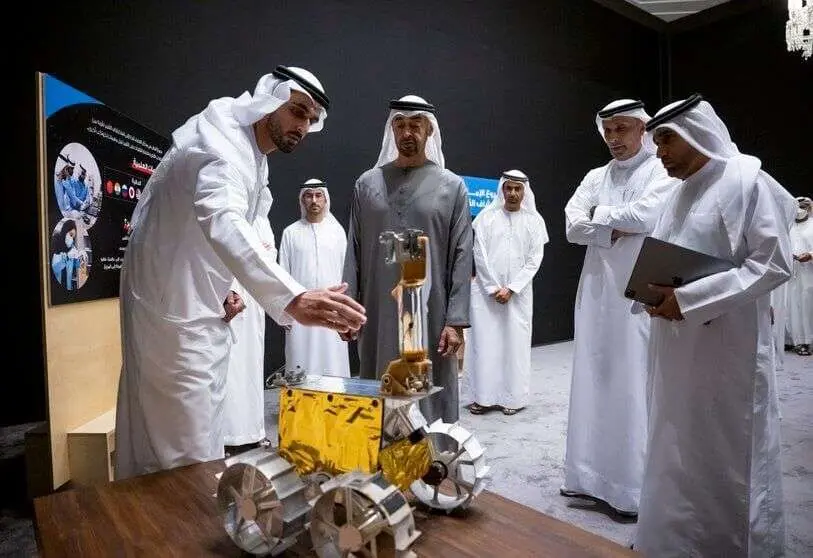Emirates and Japan have just blasted off from Earth to reach the moon together

The flag of the Union of Arab Emirates is once again flying in outer space. But this time it is on its way to the Moon and not to the orbit of Mars, where the Gulf country has been present since 9 February 2021.
Thanks to the support of Japanese technology, Emirates now wants to reach the moon and move a small four-wheeled vehicle weighing just 10 kilos over its surface. It is named Rashid, after Sheikh Rashid Al Zayed, the country's founder, who had the opportunity to meet the American astronauts who took part in the Apollo-Soyuz mission in July 1975.

Rashid is the second part of the Emirates' ambitious robotic space exploration programme, whose first step - also with the help of Japan - was to place a 1,350-kilogram space probe around the Red Planet to study its atmosphere and the keys to its seasonal changes.
After two aborted liftoffs on 1 and 2 December, the small rover, which has just been launched, has been on its way to the Moon since the early hours of Sunday morning, 11 December (Spanish time). But it did not set off from the Japanese Tanegashima space base aboard a Japanese H-II launcher, as was the case with the Al Amal spacecraft.
This time it has taken off from Cape Kennedy (Florida), where a Falcon 9 rocket from Elon Musk's company SpaceX - the recent major shareholder of the social network Twitter - has placed it on course for the Earth's natural satellite.

The recently launched Rashid lunar mission and the veteran Al Amal Martian mission are very different from each other in many respects. But both are packaged under a common denominator: the UAE was the first Arab nation to reach Mars orbit and also wants to take a pre-eminent place on the Moon.
If the mission is successful, Japan and the UAE will rank fourth and fifth in the list of countries that have successfully landed on the Moon and landed a rover on its surface, a feat only achieved by the United States, Russia and China.
Lest there be any doubt, Emirati President Mohamed bin Zayed Al Nahyan is prepared to pour in the money and resources needed. He wants to turn his country into a major international space player, a force to be reckoned with in future robotic and manned exploration programmes in the solar system, especially NASA's Artemis project to send humans back to the moon.

Rashid is the Gulf state's first lunar mission. It aims to explore areas of the moon "where no robotic mission has gone before", says Salem Al Marri, director general of the Mohammed bin Rashid Space Centre, the institution that manages the national space programme. Because of its small size - about half a metre long - the mini rover must travel and survive for at least 14 days on Earth, and withstand temperatures of around -183 degrees Celsius.
The small rover has to study the properties of the lunar soil, its orography and geology. It has four cameras, two high-resolution cameras to guide the technicians operating the rover from the ground. A third is used to get close-ups of the lacerating lunar dust. A fourth camera will study the thermal properties of the surface and a Langmuir probe will measure electron temperature, electron density and the electrical potential of the plasma. But this is not the end of the Moon's interest. In the middle of the decade, the Rashid 2 mission will be launched on board the Chinese Chang'e-7 mission.

The Emirati lunar mission is part of the Japanese Hakuto-R mission led by the private Japanese company Ispace, owned by Japanese entrepreneur Takeshi Hakamada. Hakuto-R - White Rabbit in Japanese mythology - is a descent module more than 2 metres high, with the capacity to hold some 350 kilos of various payloads.
Hakuto-R has set out on its path to the Moon more than 1.5 million metres away from the Earth, to describe a long, low-energy route rather than a direct approach, which is much more costly in terms of fuel consumption. This means that the approach trajectory to Selene will take more than four months.

At the end of its wanderings through space, the Japanese module will position itself around the natural satellite and describe orbits ever closer to its surface. Finally, it will deploy its four articulated legs and make its descent, which will take place towards the end of April, at a date not yet specified by Ispace. If the descent is a success, it will be a success for Japan and its entrepreneurs.
The chosen landing site is near the Atlas crater, an unexplored area on the outer edge of the so-called Mare Frigoris, or Sea of Cold. The area is illuminated for many hours by the sun, which will hit the solar panels and recharge the batteries. It is also a place with good visibility on Earth, which makes it easy to send data and images to "share with interested local and international research centres," says Salem Al Marri.

The Hakuto-R module has two other important passengers on board. One is a tiny two-wheeled rover, the size of a baseball, developed by the Japanese space agency (JAXA). The other is a very small satellite, also the size of a briefcase, which has been developed by the Jet Propulsion Laboratory (JPL) and is called the Lunar Flashlight.
The purpose of Lunar Flashlight is to detect the presence of water ice deposits inside the Moon's craters that are in the vicinity of the South Pole and in constant penumbra. Several near-infrared laser cameras and a spectrometer will map the ice layers that exist in these dark regions. If water ice is discovered, astronauts on future manned missions in NASA's Artemis programme will have a valuable resource for their survival and to facilitate their work.









